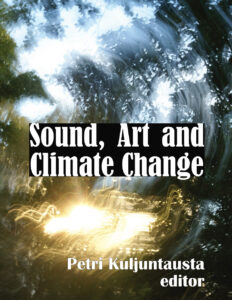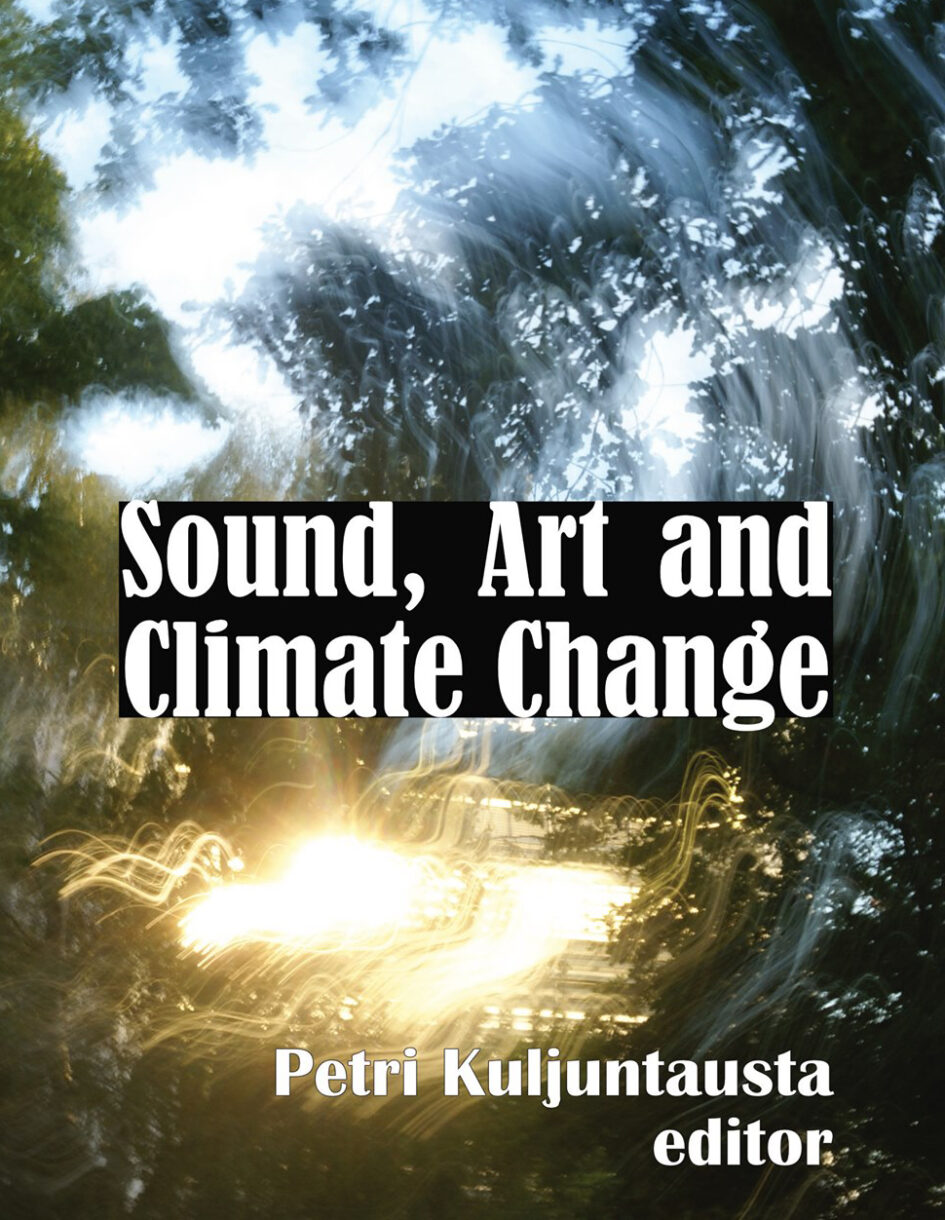 Akusmata is the name of a Sound Art Gallery in Finland. Open since 2012, its founder Petri Kuljuntausta, who is a sound artist and composer himself, arranges sonic exhibitions and concerts. Now he has collated and edited this book “Sound, Art and Climate Change” in which thirteen composers from across the world, including Petri himself, have written articles on their experience of environmental sound and climate change, and the way it has influenced their thinking and work. A separate accompaniment is a CD “CChanges”, which features pieces from seven of the composers and provides aural context.
Akusmata is the name of a Sound Art Gallery in Finland. Open since 2012, its founder Petri Kuljuntausta, who is a sound artist and composer himself, arranges sonic exhibitions and concerts. Now he has collated and edited this book “Sound, Art and Climate Change” in which thirteen composers from across the world, including Petri himself, have written articles on their experience of environmental sound and climate change, and the way it has influenced their thinking and work. A separate accompaniment is a CD “CChanges”, which features pieces from seven of the composers and provides aural context.
Starting with the book, each of the artists interprets the subject in different and interesting ways. What we have is a series of essays, a couple of poems and a kind of monologue with each artist’s personal experiences of life and places, accounts of transformations and autobiographies, all translated to musical concepts and explained generously. The mood ranges from Ava Grayson’s confusion and feeling of helplessness in the face of everyday life challenges and consumerism to the apocalyptic and even paranoid yet well-evidenced observations of Esa Kotilainen. In “Broken Nature – Broken Lives” Bernie Krause writes of his home in Northern California being destroyed by forest fires in 2017 and ironically the loss of his library of natural soundscapes and much more. As you could expect much of the discussions in the essays concern the recording and analysis of sounds. The essays are more reality based than I might have expected from a collective of experimental artists. But then sound art is based on reality, whether it’s the sounds of birds and nature, or those of urban life. As Petri Kuljuntausta explains in his piece, in the foreground are the sound groupings: biophonic (animals), geophonic (non-living sounds of nature such as winds and waves), anthropophonic (city, machines and people) and hybrid (any combination of the others). The sound artist blends into this soundscape. The conclusions are far from being the same. Each text presents a unique perspective. In a conversation with himself, Budhaditya Chattopadhyay. controversially suggests that the recording of sounds is akin to a white colonialist tool like a form of entrapment. Then in “The Soundscapes of my Life” Jukka Andersson sees the development of sound recordings and the use of processed sounds as potentially adding value to the listening experience. The common theme of these pieces is that each of the artists have noted climate and environmental changes through the different sounds around them, and have adapted their musical creations in response. The thinking is profound, so much so that it sometimes needs re-reading, but It is also noticeable how humble and grounded many of the artists are. A number of times the artists make the point that their experiences and contributions are not going to change the world in themselves. This is a riveting and at times challenging book on an important subject by a varied collection of artistically minded and caring human beings.
 The book in itself provides sharp and thoughtful insights. The “CChanges” CD comprises seven bold musical interpretations on the subject. Every piece stands out and strikes a balance between triggering the listener’s imagination and confronting us. Ambient foreboding dominates Jukka Andersson’s “The Occurrence”. There is birdsong to start but the rising drone takes over, returning to crackling sounds and dripping water. The atmosphere is one of desolation. I felt the strength of tension
The book in itself provides sharp and thoughtful insights. The “CChanges” CD comprises seven bold musical interpretations on the subject. Every piece stands out and strikes a balance between triggering the listener’s imagination and confronting us. Ambient foreboding dominates Jukka Andersson’s “The Occurrence”. There is birdsong to start but the rising drone takes over, returning to crackling sounds and dripping water. The atmosphere is one of desolation. I felt the strength of tension
between humans and nature, both represented in Ava Grayson’s nightmarish “Green Wars”. Esa Kotilainen’s “Thoughts” is similarly disturbing as we hear the hubbub of people and sirens and overwhelming city life, and violent as it sounds as if everything is coming crashing down. Elsewhere the natural worlds of bird song and sea shores are explored. But whilst bird song provides the constant, human-free backbone of Ana Gutieszca’s “In the Birds’ Jungle”, Mikko H. Haapoja’s sharp Middle Eastern sounding electroacoustic bowed lyre combined with the sound of traffic, seagulls, the rain and the lapping tide on his “Our Shorelines” collage present a more sinister and confronting face. In a similar vein, Petri Kuljuntausta’s “Disappearing Shorelines” is like the soundtrack to a bleak and uncertain future. An incredibly powerful statement, lapping water is enhanced by sharp and sinister acoustic guitar patterns, breaking in the middle and returning in a more disturbing way. It’s actually quite frightening. Visual sound artist Heikki Lindgren’s minimalist piece “Heard from the Shore” takes natural sounds from under water and stormy seas and creates something not only sinister, but angry and even violent. Each of the pieces is vivid, powerful and dramatic. Much of it is harsh, but this is the reality. Never has so much been expressed with such a combination of natural and unusual sounds, but this is the creative domain of the experimental sound artist.
Quite apart from the fact that this is a worthwhile project with important messages, the intelligent and humane insights through the words and the experimental music make both the “Sound, Art and Climate Change” book and the “CChanges” CD something rather special.
(Andrew Doherty 8.5/10)
https://frekvenssi.bandcamp.com/merch

Leave a Reply